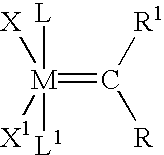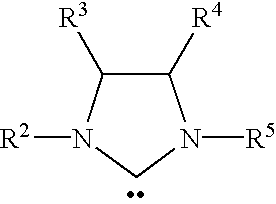Metathesis-active adhesion agents and methods for enhancing polymer adhesion to surfaces
a technology of adhesion agent and surface, applied in the field of new adhesion agents, can solve the problems of increasing the risk of delaminating or “peeling” a polymer coating from a surfa
- Summary
- Abstract
- Description
- Claims
- Application Information
AI Technical Summary
Benefits of technology
Problems solved by technology
Method used
Image
Examples
example 1
Preparation of Norbornene-Based Adhesion Agent
[0039]A 100 ml Schlenk tube equipped with a magnetic stirring bar was charged with SiCl4 (Aldrich, 50 ml of 1.0 M solution in CH2Cl2), followed by addition of 8 ml of NEt3. To the stirred SiCl4 solution was slowly added 6 ml of 5-norbornene-2-methanol (Aldrich), evolving heat and a copious amount of white precipitate. After the addition of the 5-norbornene-2-methanol was complete, the reaction was allowed to stir at room temperature overnight. Cannula filtration of the pale yellow reaction mixture yielded a yellow CH2Cl2 solution of the norbornene-functionalized adhesion agent.
example 2
Adhesion of Poly-DCPD to Octyltriethoxysilane (OTES)-Treated Glass Surface
[0040]A visually clean piece of plate glass was treated by pouring 5 mL neat OTES onto the substrate and allowing the liquid to stand for 15 h. The remaining liquid was wiped away and the substrate was placed in a 40° C. oven. An activated DCPD resin at 40° C.—comprising dicyclopentadiene (BF Goodrich Ultrene 99), Ethanox 702 (Albemarle), triphenylphosphine (Strem), and metathesis catalyst dichloro(dimethylvinylmethylidine)bis(tricyclopentylphosphine)ruthenium in the proportions 1000:30:1:1 parts by weight, respectively—was poured onto the treated glass and subjected to a cure cycle of 1 h at 40° C., 2 h at ambient, 1 h at 140° C. The hardened DCPD resin could easily be removed from the substrate by hand, indicating weak adhesion.
example 3
Adhesion of Poly-DCPD to Metathesis-Active Allyltriethoxysilane (ATES)-Treated Glass Surface
[0041]The procedure of Example 2 was repeated except 5 mL neat ATES was used to treat the glass substrate. When attempting to remove the hardened DCPD resin from the glass surface, areas of cohesive failure were observed in the glass substrate.
PUM
| Property | Measurement | Unit |
|---|---|---|
| Composition | aaaaa | aaaaa |
| Adhesion strength | aaaaa | aaaaa |
Abstract
Description
Claims
Application Information
 Login to View More
Login to View More - R&D
- Intellectual Property
- Life Sciences
- Materials
- Tech Scout
- Unparalleled Data Quality
- Higher Quality Content
- 60% Fewer Hallucinations
Browse by: Latest US Patents, China's latest patents, Technical Efficacy Thesaurus, Application Domain, Technology Topic, Popular Technical Reports.
© 2025 PatSnap. All rights reserved.Legal|Privacy policy|Modern Slavery Act Transparency Statement|Sitemap|About US| Contact US: help@patsnap.com


